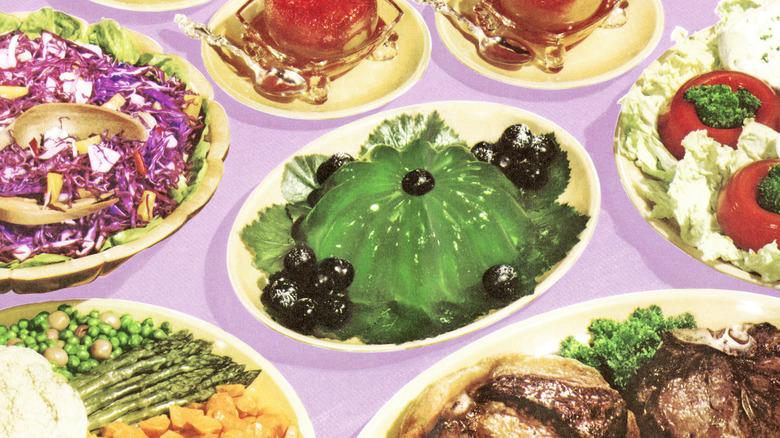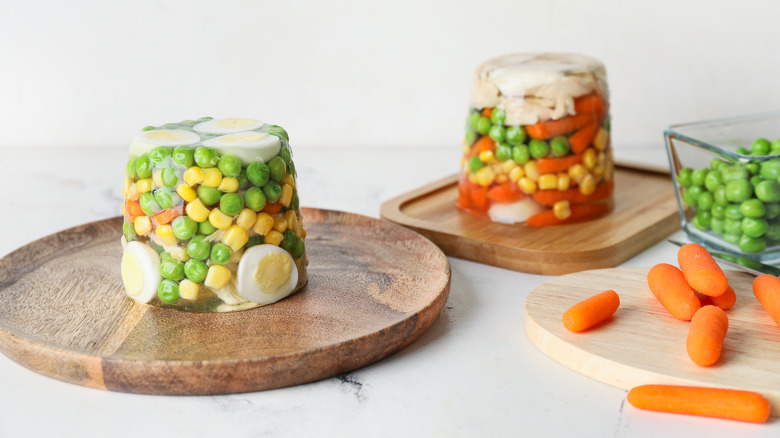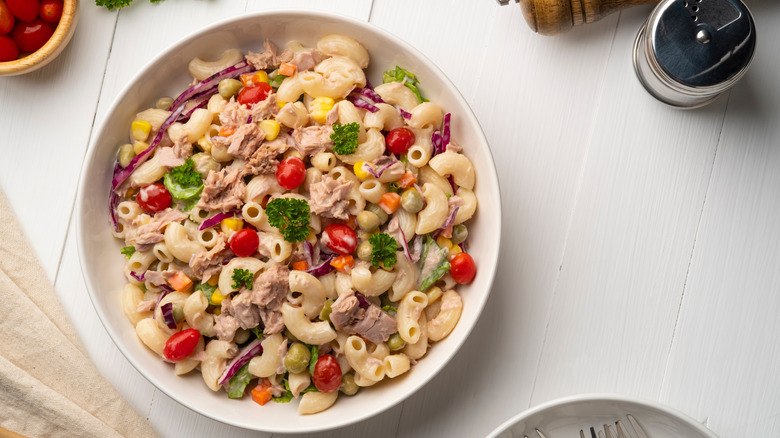Why Salads Looked A Lot Different In The Early 20th Century
Nowadays when someone says they'll bring a salad to the potluck, it's generally understood that said salad will be a combination of vegetables — sliced, diced, and tossed with lettuce or maybe some baby spinach. Once upon a time, however, salads were more often than not set in brightly colored gelatin, molded into fantastic shapes, and served on a tray.
Jell-O salads were once a kitchen standard. They certainly had a cultural moment in the 1950s with one ad advising: "Don't let a week go by without serving one," according to Click Americana. But these jiggly dishes were actually popular at the beginning of the 20th century. In the 1800s, making gelatin was a complicated process, so jellied foods were mostly eaten by the upper classes. When Jell-O was invented in 1897, the world was forever changed. Suddenly home chefs had access to the once high-society food. As industrialization increased, Jell-O became a cheap and simple way to serve up a variety of vegetables or meats and make them last. Molded salads eventually fell out of vogue in the 1970s and '80s as part of a push for healthier and fresher foods.
Today, Merriam-Webster's definition of salad memorializes two very different formats: The first is the salad we are used to today, with "raw greens (such as lettuce) often combined with other vegetables." The second definition is a nod to the dishes from your grandma's dinner parties: "small pieces of food (such as pasta, meat, fruit, or vegetables) usually mixed with a dressing (such as mayonnaise) or set in gelatin."
The rise and fall of the Jell-O salad
Jell-O salads became particularly popular during the Great Depression, as an easy way to stretch limited ingredients, utilize leftovers, and preserve food for longer. The dishes maintained their primacy in World War II when rationing limited access to fresh foodstuffs.
But the inventiveness reached new levels in the 1950s. American women were simultaneously encouraged to take advantage of the many new home technologies on the market and pressured to be ideal housewives, skilled in all domestic tasks such as cooking. Jell-O salads were an ideal way for home cooks to utilize industrialized products while showcasing kitchen virtuosity. Salads were concocted with vegetables suspended in different layers and molded into fish or towering Bundt pans. Recipes for olive relish included olives, celery, pickles, and vinegar all set in bright green lime Jell-O. Salads could include broccoli, tomato, celery, shrimp, carrots, or fish. Chefs would mix in mayonnaise or slather a layer on top of the final bouncy mold. There was even a time in the 1960s when Jell-O came in flavors such as mixed vegetable, celery, and seasoned tomato.
But from the 1970s onward, the molded salad lost its primacy, gently falling out of vogue through the '80s. Today, almost all Jell-O flavors are sweet, recommended recipes are usually meant for dessert, and the company has done a trendy rebrand to appeal to Gen Z consumers.
Modern salads inspired by the past
The legacy of the creamy gelatin salads of yore is kept alive in many of today's favorite dishes. Tips to elevate tuna salad or craft a typical Hawaiian mac salad rely on similar combinations of fish, mayonnaise, and vegetables. Chicken salad and egg salad both hit the same creamy, savory, protein-packed notes, even if they're not set in a jellied Bundt shape. It's good to remember that the definition of salad expands far beyond lettuce and tomato, and there is no need to be confined to rigid combinations and recipes. If you want to combine tuna, broccoli, and mayonnaise, you are tapping into a long history of American cuisine.
And, if you do have a hankering for some wiggly Jell-O, there are plenty of gelatin recipes that are crowd-pleasers today. Almond Jell-O topped with fruit cocktail is a Lunar New Year-inspired delight. Or combine your favorite fruit Jell-O flavor with Greek yogurt for a refreshing fruit mousse. Or even just eat some plain old strawberry Jell-O, and remind yourself that you are enjoying what was once the food of the elite.



